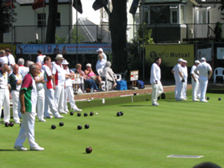Indoor Rink Width
ARE INDOOR RINK TOO
NARROW? First published in "To Day's Bowler"
in 2002
I wrote an
article sometime ago about the bias on bowls, which also covered
the testing of same. Bowlers will now all be aware that after many
years World Bowls Limited together with the manufactures and
testers have introduced (2002) a new "Working Reference Bowl (WRB)"
in conjunction with the standardisation of the test table and the
test regulations. Basically this new working reference bowl has the
same bias as the original but has been made to the much tighter
tolerances that are now possible with modern machinery compared to
the 1986 Reference Bowl.
The prototype of the Working
Reference Bowl was examined on both indoor and outdoor greens. Its
performance was also related to the 1986 reference bowl. only after all the
tests and further examination by manufacturers was it agreed that
its performance was such that it was suitable for the sport of
bowls. Its performance and bias were particularly important to the
Bowls Authority as they were acutely aware of the complaints
emanating from both overseas bowlers and bowlers in the UK about
bowls not showing sufficient bias on the
green.
It took a lot of hard work, discussion
and a great deal of expense to reach, in January 2002, a successful
conclusion to the standardisation of both the tables and the
regulations and with that agreement the new World Bowls Limited
stamp for bowls testing came into use from the 1st April
2002.
The reason that I mention the
standardisation is the knock on effect to the indoor bowls and the
bowling surfaces concerning the speed of theses surfaces and the
width of rinks. All bowlers would have heard over the years such
statements as "Oh their bowls are straight" or "they go up the
middle". Those bowls if tested on the standard surface might well
be shown to be illegal but equally there are many rinks where a
bowls performing to the new Working Reference Bowl could not be
played. on those rinks which could be described as "outside" rinks
it might not be possible to play to a full length jack on the
centre line.
Just a
short digression with a true story told to me by another
manufacturer. They received a complaint from an indoor bowler that
his bowls where now taking too much green at his club. What
couldn't be understood was that the bowler agreed that over the
previous seasons the bowls had been fine. The manufacturer on
checking with the Club found that during the Summer close season
the Club had increased the number of rinks from 6 to 7, but the
green had not expanded! So the bowler who had not noticed the fact
that each rink was now narrower thought that the bowls had
increased in bias during the summer as they did not stay within the
new rink widths! They immediately blamed the bowls! That story just
highlights the problem.
The question then is why should this be
the case that an actually minimum bias bowl can not be played, to a
full length Jack on the centre line. Could it not then be said that
the green is unsuitable for bowls! Is it because of the demand for
faster rinks or is it because of commercial pressure at the indoor
clubs? (Manufacturers have in
fact been developing Indoor model bowls that show sufficient bias
on the narrow indoor rinks BUT when bowlers use such models
outdoors they cause comment on how tight they
run)
So my
suggested solution is that the indoor authorities should ensure
that all rinks will allow a bowl made to the minimum to perform in
a adequate manner, by which I would mean that it would stay within
the rink when played either hand in either direction to a full
length jack on the centre line.
It is perhaps somewhat ironic that for
UK conditions outdoor rinks must be between 5.5 mts. and 5.8 mts.,
or for those like me who still work in feet that's about between 18
ft. to 19 ft. whereas the WIBC (World Indoor Bowls Council) allow a
rink to be between 4.6 mts. and up to 5.8 mts. or 15 ft. to 19 ft.
The rules do say that allowances can be made for domestic
competitions to have narrow rinks and this is true for both indoor
and outdoor. When it comes to a possible guide to what can be
deemed a minimum width then perhaps the following observations may
be useful. These measurements and observations where carried out
some years ago at major indoor tournaments when it was noted that
the reference bowl on a indoor carpet running at about 15 seconds
took approximately 5 1/2 ft. of draw. So theoretically a rink 12
ft. wide would have allowed a bowler to deliver to a 90 ft. jack on
the green. But note the word theoretically because no allowance was
being made for the manner in which a bowl would be delivered by
hand, the observations made did not involve a bowler. So perhaps
another 18 inches should be added making the required space 7 ft.
giving an absolute theoretical minimum of 14 ft. wide rink for a
green running at approximately 15 seconds. Any increase in the
speed of the green would require an increase in the width and a
slower green could be narrower.
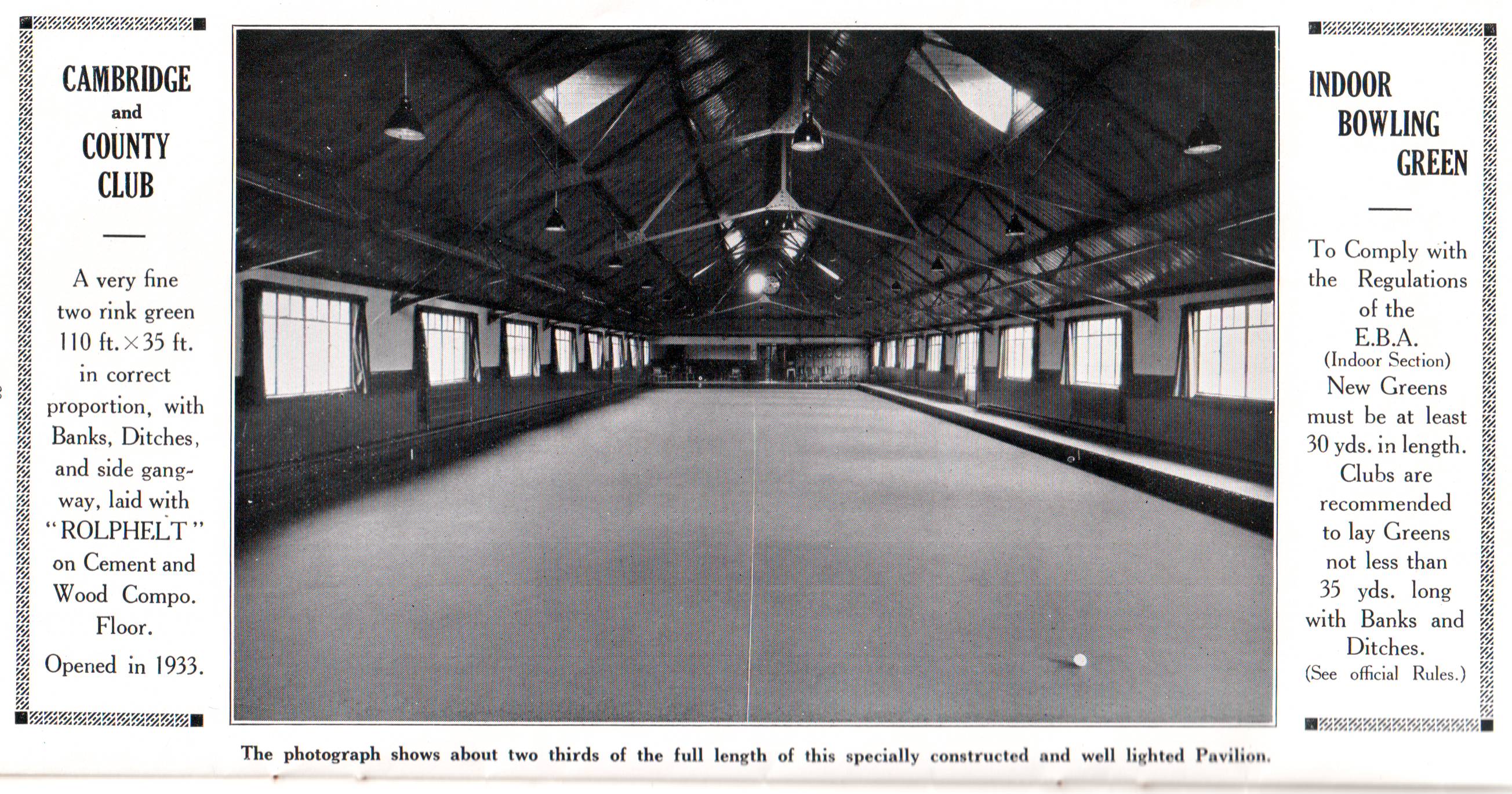
It
can be seen in the above picture that this green laid in 1933 had
rinks which were 17 ½ ft wide. Also the English Bowls Association
(Indoor Section) Rules laid down the minimum length for 'new'
rinks, but sadly the notes do not contain any information on
widths!
Other adverts from the same catalogue
indicate that the width of rinks basically depended on the space
available.
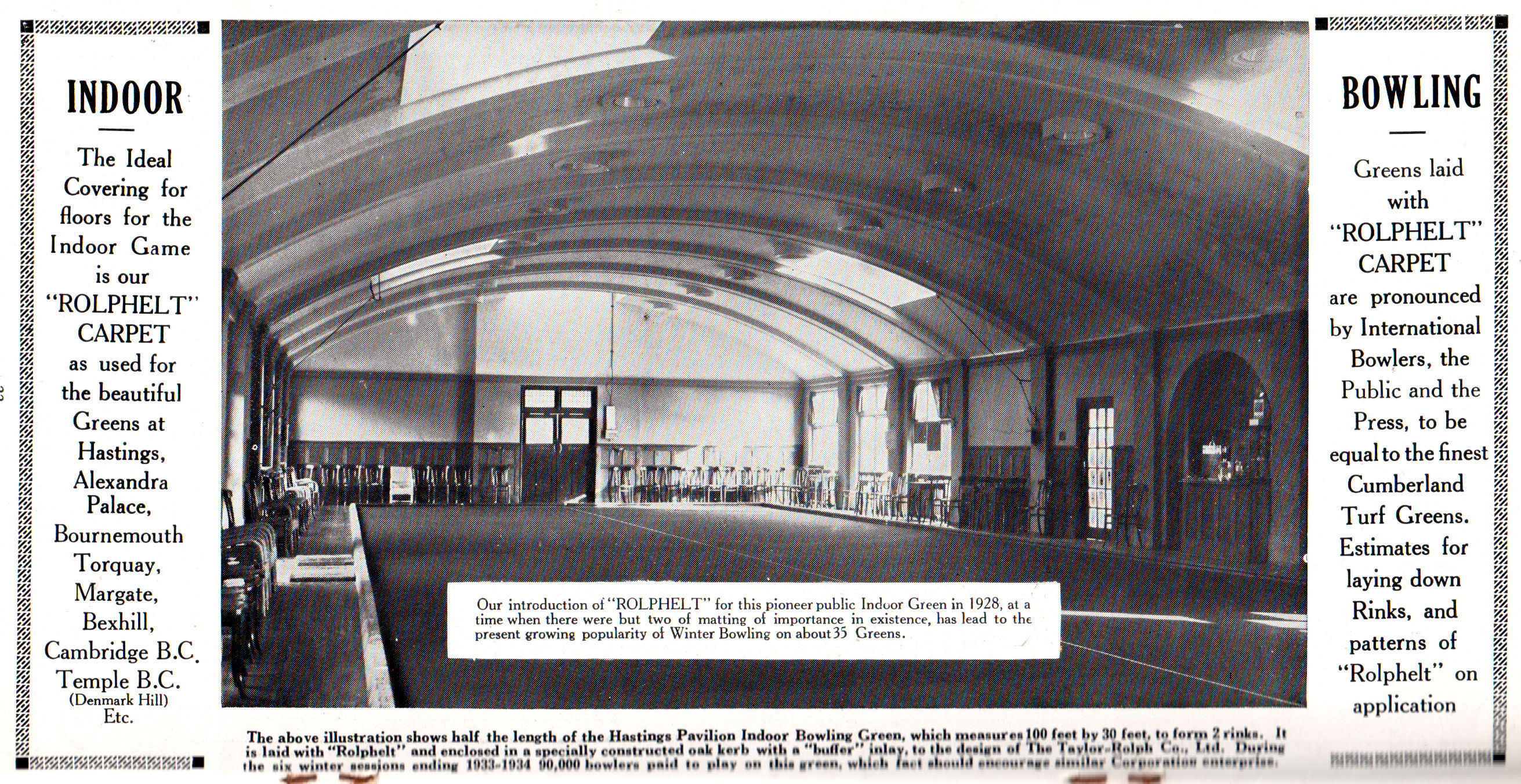
The
Hasting Pavilion carpet measured 100ft by 30 ft meaning that the
rinks were only 15 ft wide.
Whereas the Torquay Club with space for
just one Rink had it at 18ft. The size at 115ft by 18ft is said to
be "in the correct proportion for indoor bowling". So perhaps even
in the early 1930 there was some discussion on the width of
rinks!
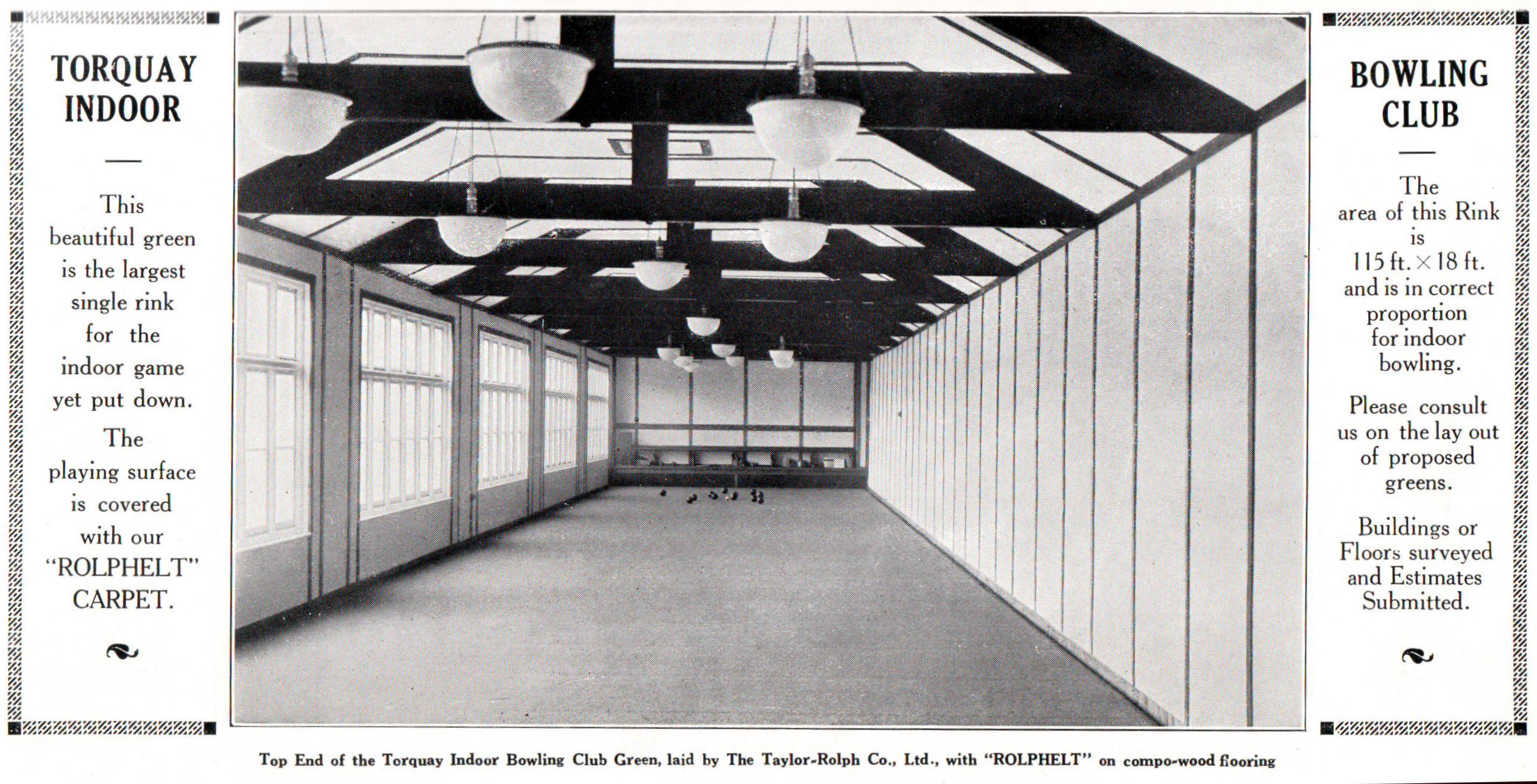
The
following advert was sent as a leaflet with a letter from Taylor -
Rolph in 1936 . It is I think interesting that the heading on the
left panel says "Indoor or Winter Bowling", little did they realise
how significant Indoor Bowling Clubs would become with the indoor
game being played all the year round.
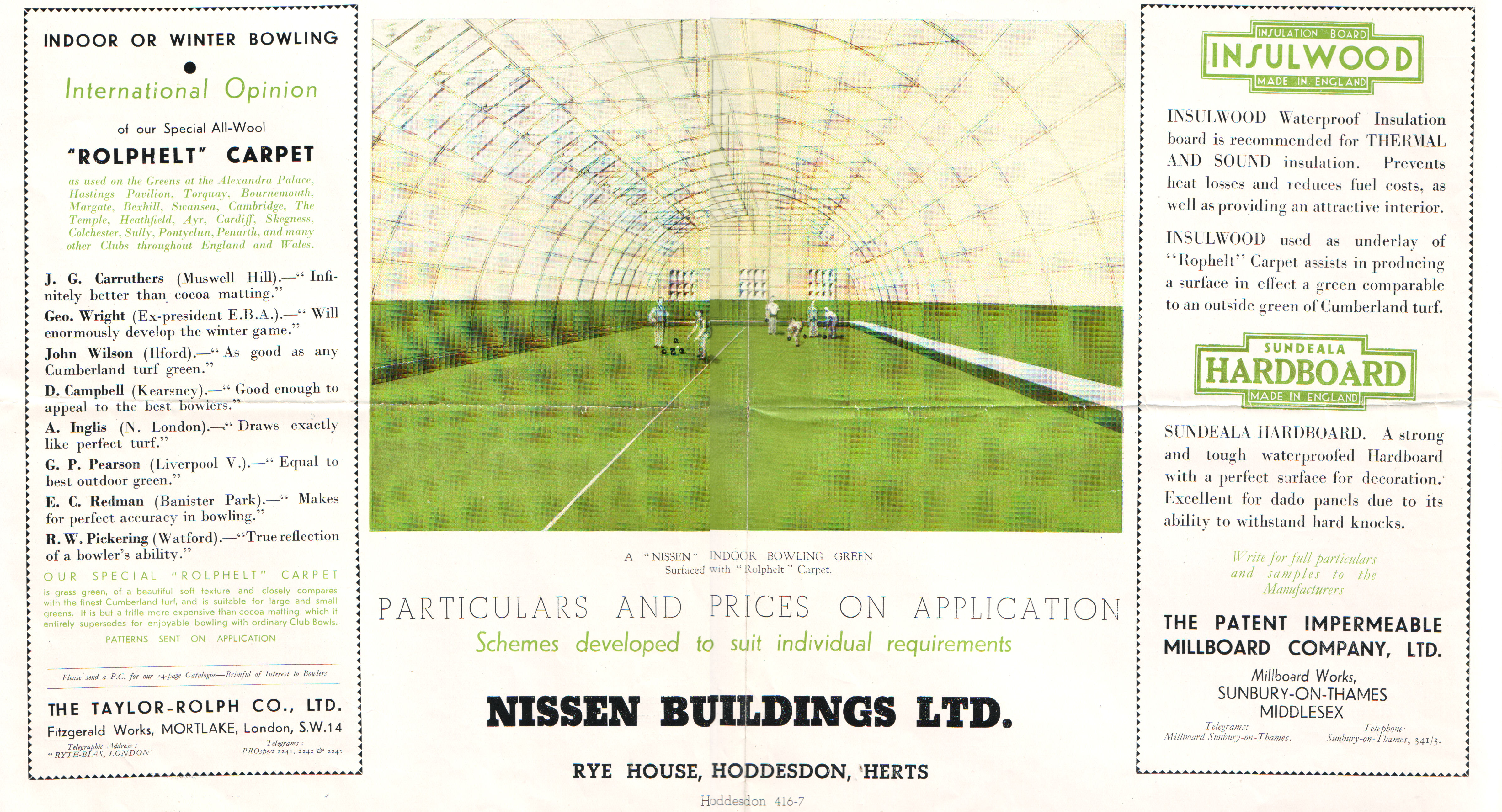
Returning
back to the rules and the possible allowances to the width of the
rink as laid down by the rules, it does seem logical that an
absolute minimum width of rink should be laid down but that would
also have to be associated with a maximum green speed and an
understanding that a minimum bias bowl could be played either hand.
Obviously this does refer to an outside rink more than the other
rinks. Or would it be possible to say that the outside rinks always
had to be to a minimum of 15 ft. as per the WIBC rules and that the
other rinks on that green could be narrower. These narrower rinks
might in some bowlers eyes be more problematic in that they may
feel inhibited if the adjoining rink had played a short jack
meaning that it made delivering on one of the hands more difficult
as the bowl would perhaps cross over into the adjoining rink.
However in both Australia and New Zealand were green speeds outdoor
are much faster, the fact that a bowl travels into the adjoining
rink is not unusual and is an accepted part of the
game.
In speaking to carpet suppliers they
advise that they can ensure a "bowl" will perform adequately and
this can be achieved by adjusting the speed of the carpet. It is
also worth noting that they say that they are under pressure to
supply faster and faster carpets, thus exasperating the problem.
Basically a "narrow" rink would have to have a slower speed
compared to a full width rink. Outside rinks will still be more
problematic particularly when the jack moves towards to the edge
put that is just part of the game and the bowler will have to
accept that they have to change hands to play to the
jack.
This final paragraph was originally
published in the magazine -
I would be interested to hear from any
indoor bowlers who have any thoughts with regard to the width of
there rinks and the bias of the bowls so please send any letters
with regards to that for my attention care of the
editor.
© Peter N. Clare 2002/2009 - © E.A. Clare
& Son Ltd. 2018.
This article can only be reproduced in part or whole with the
permission of E. A. Clare & Son Ltd.
